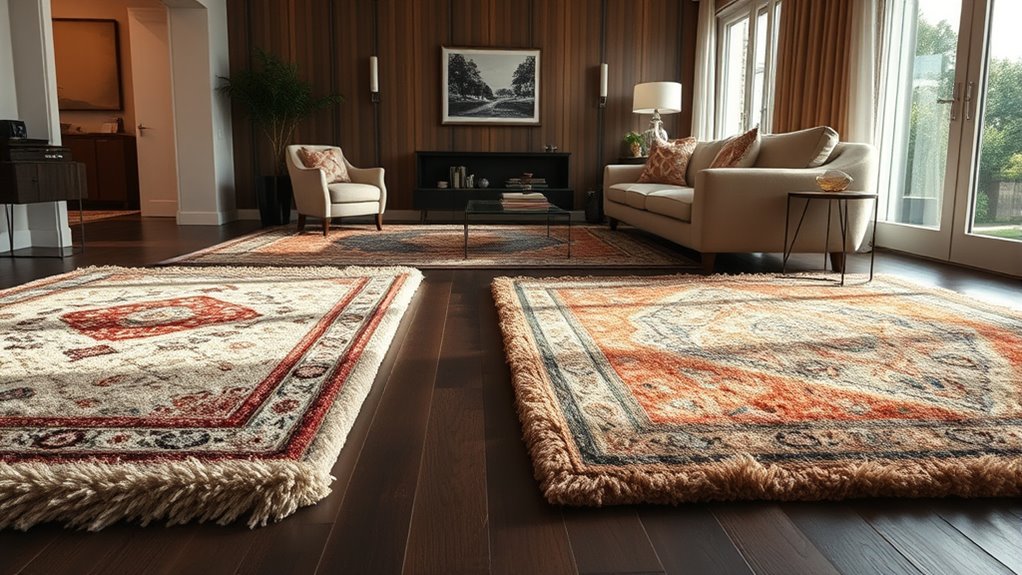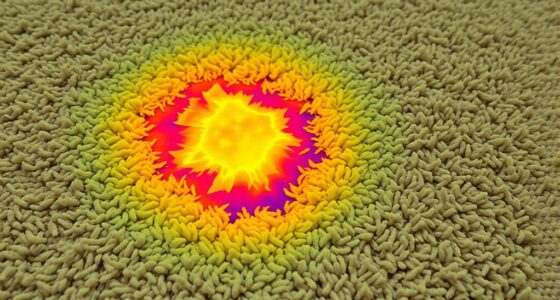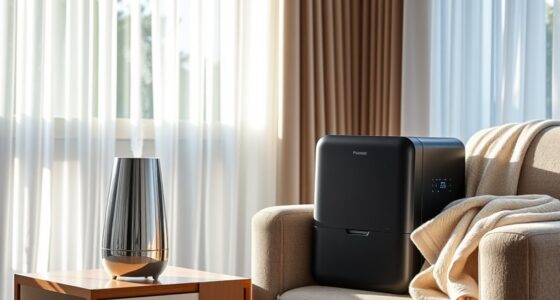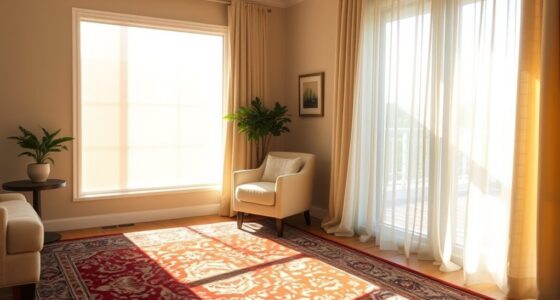Adding rugs to your space can substantially lower noise levels by absorbing sound waves and reducing echoes. Thick, dense rugs made from materials like wool or shag help dampen footsteps and ambient noise. Proper placement in high-traffic areas or layered on hard floors enhances their effectiveness. Combining rugs with other soundproofing methods boosts your acoustic makeover even more. Keep going to discover practical tips that will maximize your noise reduction efforts.
Key Takeaways
- Rugs absorb sound waves, reducing echo and reverberation in a room.
- Thicker, denser rugs provide greater decibel reduction by dampening more sound frequencies.
- Proper placement of rugs in high-traffic and hard surface areas maximizes noise absorption.
- Combining rugs with other soundproofing methods enhances overall decibel reduction.
- Regular maintenance of rugs maintains their sound-absorbing qualities and acoustic benefits.
How Rugs Absorb Sound and Improve Acoustics

Rugs play a crucial role in absorbing sound waves and reducing noise levels in a room. When you walk on a rug, it cushions your steps, providing underfoot comfort that makes movement quieter and more comfortable. This absorption helps prevent sound from bouncing off hard surfaces, improving the room’s overall acoustics. Additionally, rugs add aesthetic enhancement, transforming a plain space into a cozy, inviting environment. The fibers and thickness of the rug trap sound energy, minimizing echo and reverberation. By choosing the right rug, you not only boost the room’s visual appeal but also create a more peaceful atmosphere. Moreover, selecting a rug with appropriate sound absorption qualities can further enhance acoustic performance. For optimal results, consider the materials used in rugs, as they significantly influence sound dampening capabilities. Understanding the energetic properties of different rug materials can help you select options that promote a calmer environment. Certain rug designs and textures can also contribute to better sound insulation. Whether placed in a living room or bedroom, the right rug effectively dampens noise and enhances comfort, making your space more enjoyable.
Types of Rugs Best for Noise Reduction
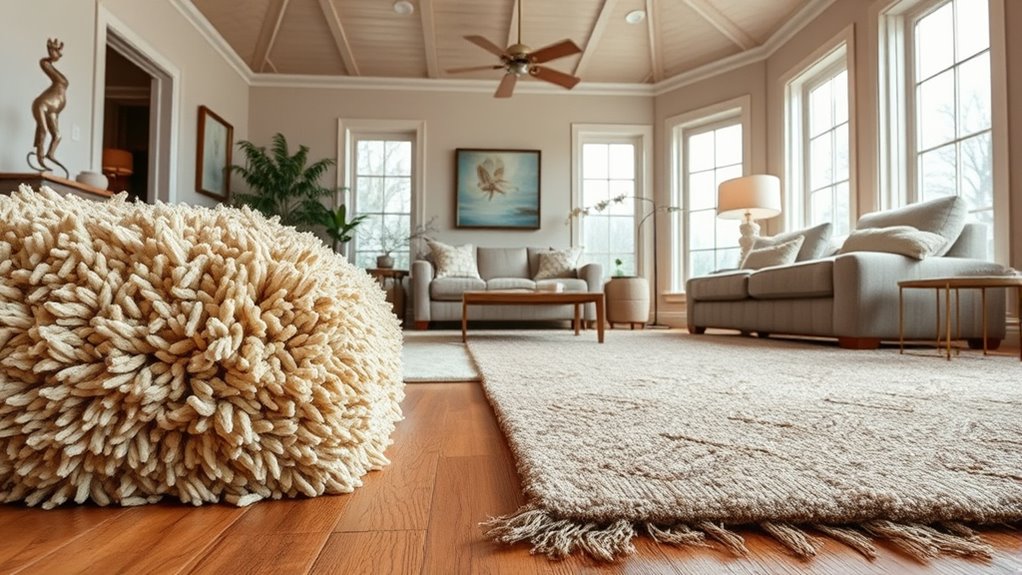
To maximize noise reduction, opt for rugs with dense, thick fibers that effectively trap sound waves. Felted wool or shag rugs are excellent choices, as their substantial pile absorbs more sound than thin, flat weaves. When selecting decorative patterns, go for textured designs that add visual interest while enhancing acoustic benefits. Bold patterns can also hide stains or wear, maintaining aesthetics over time. Consider your color preferences; darker shades tend to hide dirt and complement various decor styles, while neutral tones keep the space feeling light and open. The key is choosing rugs that combine dense materials with appealing designs, ensuring both soundproofing and visual harmony in your space. Prioritize quality and texture to get the best noise-reducing results. Incorporating textile art techniques into your rug selection can also contribute to improved sound absorption and aesthetic appeal. Additionally, paying attention to soundproofing properties of the materials can further optimize noise reduction in your environment. Selecting rugs with high fiber density can significantly enhance acoustic performance, making your space quieter and more comfortable.
Optimal Placement Strategies for Maximum Effect
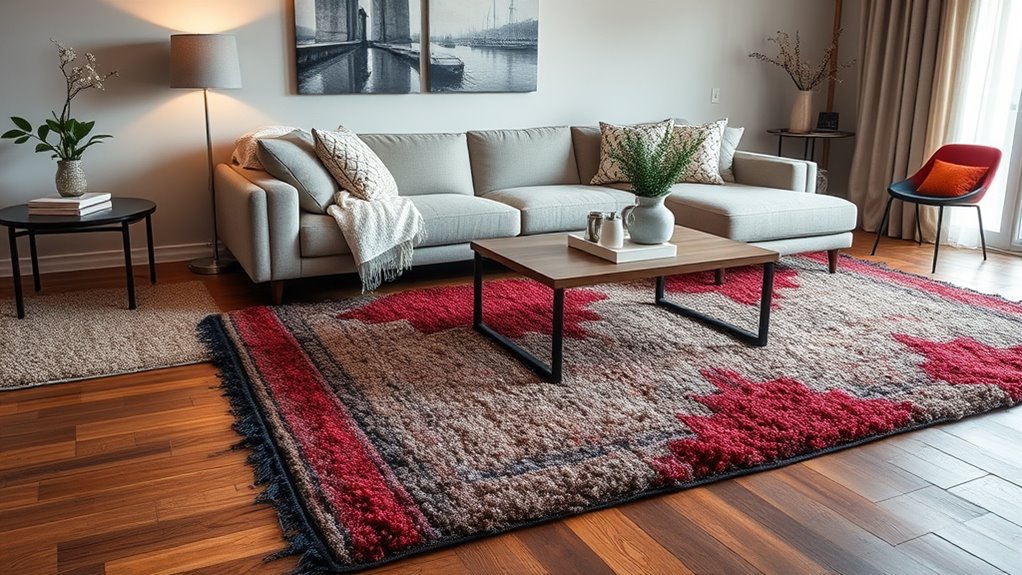
Strategic placement of rugs can considerably enhance their noise-reducing effectiveness. Position rugs in high-traffic areas like entryways, hallways, and beneath furniture to absorb sound where it’s most concentrated. Layer rugs in spaces with hard flooring to create multiple sound barriers, amplifying their impact. When choosing rugs, consider decorative patterns that visually complement your room, encouraging placement in prominent spots. Color choices also matter; lighter shades can brighten spaces and draw attention to specific areas, while darker hues hide dirt and wear, maintaining their appearance longer. Avoid placing rugs in corners or tucked away in less-used rooms if you aim for maximum sound absorption. Instead, focus on central locations and areas where sound tends to bounce, ensuring your decorative patterns and color choices work together to optimize both style and acoustics. Additionally, selecting rugs with dense fibers can further improve their sound absorption ability, providing an even quieter environment. Incorporating layers of different textures can also contribute to reducing noise effectively as indicated in soundproofing research. Using proper placement techniques can significantly increase the overall acoustic benefits of your rugs, making your space more comfortable and serene.
Comparing Rug Materials and Their Soundproofing Capabilities
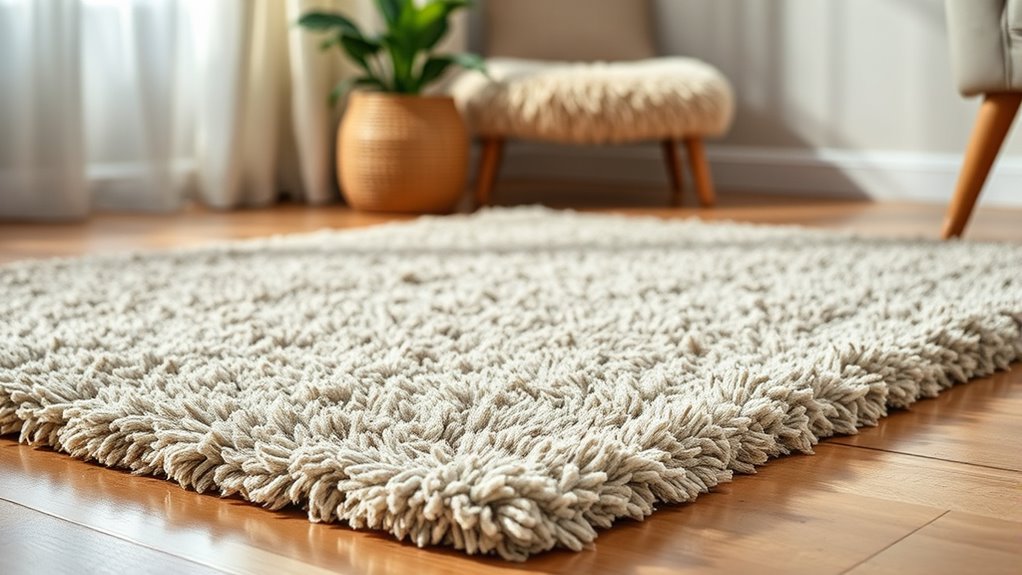
When choosing rugs for soundproofing, you’ll notice that wool often absorbs noise better than synthetic fibers. Thicker and denser rugs generally provide more decibel reduction, regardless of material. Understanding these differences helps you pick the best rug for quieter, more comfortable spaces.
Wool vs. Synthetic Fibers
Have you ever wondered which rug material offers better soundproofing—wool or synthetic fibers? Wool naturally absorbs sound due to its dense, fibrous structure, making it effective at reducing noise. It also holds up well during rug cleaning, maintaining its soundproofing qualities over time. Synthetic fibers, like nylon or polyester, are often less dense but can be engineered to enhance sound absorption. They’re usually more affordable and come in a wide range of styles, boosting your room’s aesthetic appeal. Additionally, rug density can inform your expectations regarding the effectiveness of different materials in various environments. Furthermore, the fiber structure of wool contributes significantly to its superior acoustic performance compared to synthetic options. The density of a rug directly impacts its ability to dampen sound waves and reduce echo within a space.
Thickness and Density Effects
Thicker and denser rugs generally provide better soundproofing because they absorb and block more noise. The increased material density reduces sound transmission, making your space quieter. When choosing rug materials, consider how thickness impacts both decibel reduction and durability; thicker rugs tend to last longer, offering enhanced rug durability. Keep in mind that while dense, heavy rugs improve sound absorption, they can also influence the aesthetic appeal of your room, adding texture and visual interest. Additionally, material density plays a crucial role in optimizing soundproofing performance. Choosing the right rug materials can also complement your bedroom decor style, creating a cohesive and inviting space. Moreover, understanding the compatibility of materials with your environment can further enhance soundproofing effectiveness. However, balance is key: overly thick rugs may be less practical for high-traffic areas. Regional culinary arts insights from local food experiences highlight the importance of selecting materials that complement your environment. Ultimately, selecting a rug with the right thickness and density helps optimize soundproofing while maintaining the style and longevity you want.
The Role of Rug Thickness and Density in Noise Control
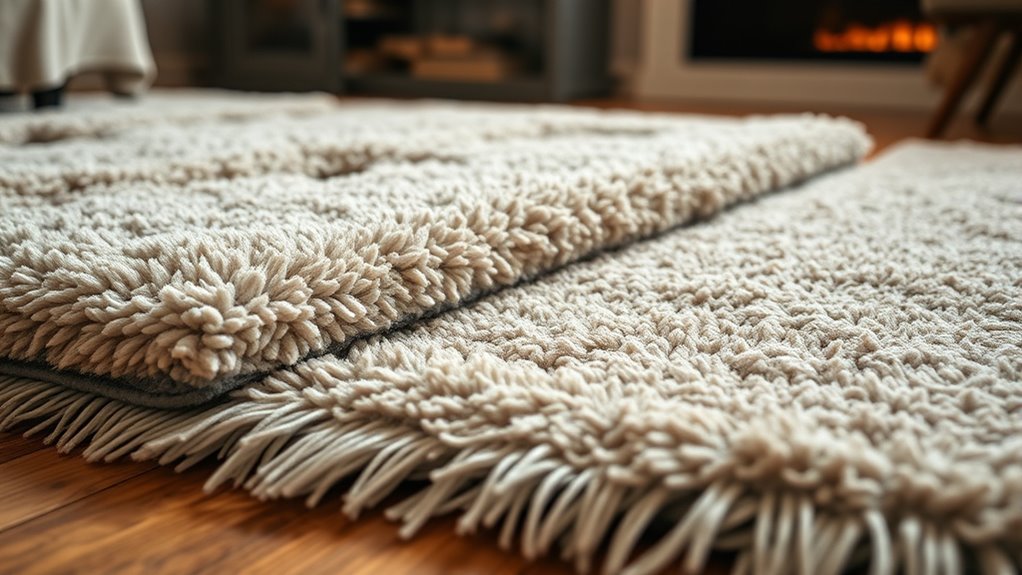
The thickness and density of a rug play essential roles in how effectively it reduces noise. Thicker, denser rugs absorb a broader range of sound frequencies, making your space quieter. They also influence the aesthetic design, adding texture and visual appeal. Consider these factors: 1. Thicker rugs target low to mid sound frequencies, dampening echoes and footsteps. 2. Higher density materials improve overall sound absorption, minimizing noise transmission. 3. The combination of thickness and density enhances both acoustic performance and aesthetic appeal, creating a harmonious balance. Additionally, choosing appropriate materials can further optimize noise reduction while enhancing interior style. Incorporating sound absorption techniques like using rugs can significantly improve acoustic comfort in your space. Furthermore, understanding the relationship between rug properties and noise control can help you select the best options for your environment.
Combining Rugs With Other Soundproofing Methods

You can boost your noise reduction by layering rugs with other soundproofing methods. Combining techniques like acoustic panels or sealants creates a more effective barrier against sound. When used together, these strategies work synergistically to considerably cut down noise levels in your space. Using soundproofing materials such as specialized curtains or mass-loaded vinyl can further enhance your soundproofing effectiveness.
Layering Soundproofing Techniques
Combining rugs with other soundproofing methods can considerably enhance noise reduction in your space. You can layer techniques to maximize decibel reduction while maintaining style. Consider these options:
- Install acoustic panels with decorative accents that complement your rugs, creating visual harmony through color coordination.
- Use door seals or weather stripping to block sound leaks, pairing them with rugs to absorb residual noise.
- Add mass-loaded vinyl behind wall coverings or within ceilings to boost soundproofing without sacrificing aesthetics.
Synergistic Noise Reduction
By integrating rugs with other soundproofing methods, you can create a powerful synergy that substantially reduces noise levels in your space. Select rugs with decorative patterns and bold color schemes to enhance visual appeal while absorbing sound. Pairing these with acoustic panels or ceiling tiles maximizes decibel reduction, as different materials target various sound frequencies. For example, placing rugs with textured surfaces on floors complements wall treatments, creating a layered sound barrier. Coordinating color schemes guarantees a cohesive aesthetic that complements your decor, making the noise reduction seamless and visually appealing. Combining these strategies allows you to tailor your environment for maximum comfort and tranquility, making your space not only quieter but also more stylish and inviting.
Measuring Noise Reduction: What to Expect
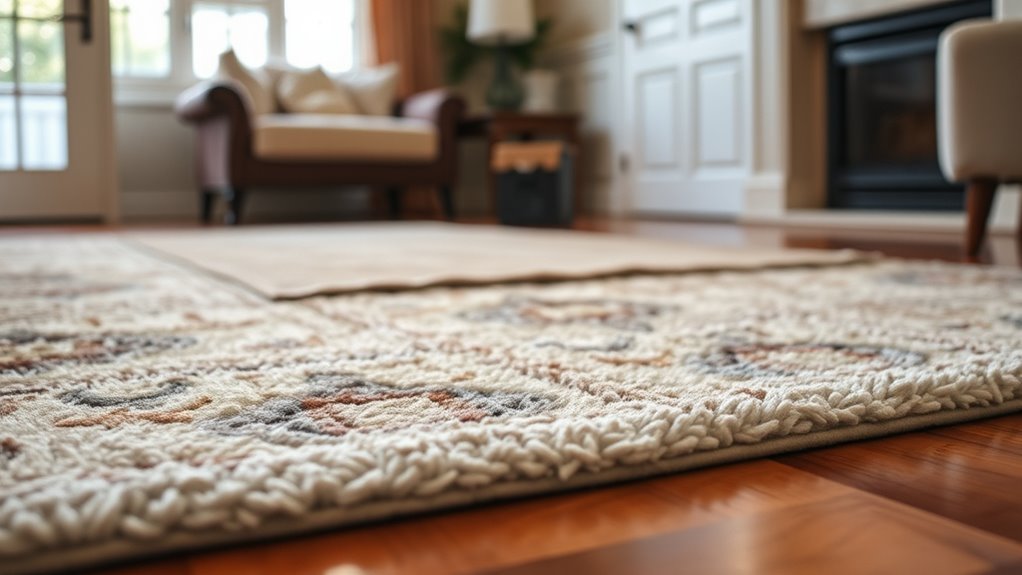
Measuring noise reduction after adding rugs involves understanding how sound levels change in your space. When evaluating results, expect a noticeable decrease in ambient noise, though it varies based on room size and materials. To accurately gauge improvements, consider:
- Using a decibel meter to record baseline sound levels before and after installing rugs.
- Comparing the impact of flooring upgrades, like replacing hard surfaces with carpets, to maximize sound absorption.
- Assessing the combined effect of rugs and window treatments, which further dampen sound transmission.
Keep in mind, the overall noise reduction may be modest but significant enough to improve comfort. Precise measurements help you understand how your efforts contribute to a quieter environment, guiding future acoustic enhancements.
Maintenance Tips to Preserve Acoustic Benefits
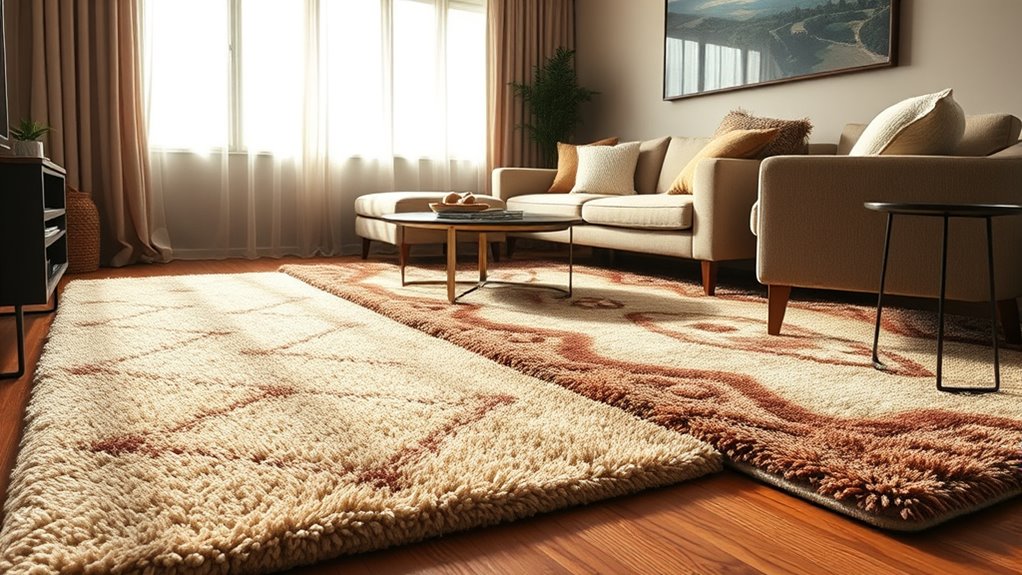
To guarantee your rugs continue to provide effective noise reduction, regular maintenance is essential. Proper rug maintenance not only keeps your floors looking fresh but also supports acoustic preservation. Vacuum your rugs weekly to remove dust and debris that can diminish their sound-absorbing qualities. Rotate and flip rugs periodically to prevent uneven wear, ensuring consistent decibel reduction. Address spills and stains promptly to maintain the rug’s integrity and acoustic properties. Avoid using harsh chemicals that could damage fibers, reducing their ability to absorb sound. Regularly inspect for loose or frayed edges and repair them to prevent further damage. By maintaining your rugs diligently, you preserve their acoustic benefits, creating a quieter, more comfortable environment. Consistent care maximizes your investment in noise reduction.
Frequently Asked Questions
Can Rugs Completely Eliminate Noise in a Room?
Rugs can’t completely eliminate noise in a room, but they substantially reduce sound levels. You can enhance their effectiveness by choosing rugs with thick carpet padding and using materials like wool or dense fibers. These features help absorb sound waves, minimizing echoes and noise transmission. While they won’t make a room entirely silent, adding quality rugs with proper padding makes a noticeable difference in creating a quieter, more comfortable environment.
How Do Rugs Compare to Wall Treatments for Soundproofing?
You’ll find that rugs offer a softer, decorative accent that helps absorb sound, but they don’t match wall treatments for soundproofing. Rugs are easy to move and add material durability, but wall treatments provide a more all-encompassing barrier against noise. While rugs improve acoustics in a room, combining them with wall treatments maximizes decibel reduction, giving you a more effective and stylish soundproofing solution.
Are There Specific Rug Patterns That Enhance Sound Absorption?
Certain rug patterns can boost sound absorption, especially those with dense, textured designs. Pattern variety matters—larger, intricate patterns with thick fibers tend to absorb more sound than simple, flat weaves. While color influence is minimal, darker or muted tones may visually enhance a cozy, sound-absorbing space. Choose rugs with rich textures and varied patterns to maximize decibel reduction and create a more peaceful environment.
How Long Do Sound-Absorbing Benefits of Rugs Typically Last?
You wonder how long the sound-absorbing benefits of rugs last. Generally, their durability lifespan depends on the rug’s material and quality, but with proper maintenance, you can prolong their effectiveness. Regular vacuuming and occasional deep cleaning help preserve their soundproofing properties. On average, expect these benefits to last several years, though high-traffic areas may require more frequent maintenance to ensure continued decibel reduction.
Can Rugs Reduce Noise From Outdoor Sources Effectively?
Outdoor noise can seem like an unbreakable wall, but rugs can markedly help reduce it. By strategically placing rugs near windows or outdoor entry points, you create a barrier that absorbs and dampens sound waves. While they won’t eliminate all noise, they’re surprisingly effective at muffling loud outdoor sources. Proper rug placement maximizes this effect, making your space quieter and more peaceful, even when the world outside is loud as a thunderstorm.
Conclusion
By layering rugs thoughtfully, you can considerably soften sounds and create a calmer, cozier space. Embrace the ease of effective ear-enriching enhancements through strategic placement, sturdy materials, and regular maintenance. With mindful measures, you’ll maximize your muffling marvels, making your environment more peaceful and pleasant. Transform your terrain into a tranquil sanctuary by tackling noise with simple, stylish solutions — because a quieter, more comfortable space is just a rug away.
